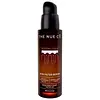What's inside
What's inside
 Key Ingredients
Key Ingredients

 Benefits
Benefits

 Concerns
Concerns

 Ingredients Side-by-side
Ingredients Side-by-side

Water
Skin ConditioningGlycerin
HumectantCaprylic/Capric Triglyceride
MaskingIsopentyldiol
HumectantTrioctyldodecyl Citrate
EmollientCitrullus Lanatus Seed Oil
Emollient1,2-Hexanediol
Skin ConditioningRubus Idaeus Seed Oil
EmollientPanthenol
Skin ConditioningTriolein
Skin ConditioningRetinal
Skin ConditioningCeramide NP
Skin ConditioningTocopherol
AntioxidantRetinol
Skin ConditioningTocopheryl Acetate
AntioxidantHaematococcus Pluvialis Extract
AntioxidantHydroxyethyl Acrylate/Sodium Acryloyldimethyl Taurate Copolymer
Emulsion StabilisingCopernicia Cerifera Wax
Pongamia Glabra Seed Oil
Skin ConditioningGlyceryl Dioleate
EmollientBisabolol
MaskingAllantoin
Skin ConditioningDunaliella Salina Extract
Skin ConditioningEthyl Ferulate
AntioxidantHumulus Lupulus Extract
AntimicrobialZingiber Officinale Root Extract
MaskingArginine
MaskingPropanediol
SolventCellulose Gum
Emulsion StabilisingSclerotium Gum
Emulsion StabilisingUbiquinone
AntioxidantLactic Acid
BufferingSodium Phytate
Caprylyl Glycol
EmollientInulin
Skin ConditioningDisodium Cocoamphodiacetate
CleansingHelianthus Annuus Seed Oil
EmollientPolysorbate 20
EmulsifyingCitric Acid
BufferingCellulose
AbsorbentFructose
HumectantGlucose
HumectantSorbitan Isostearate
EmulsifyingXanthan Gum
EmulsifyingWater, Glycerin, Caprylic/Capric Triglyceride, Isopentyldiol, Trioctyldodecyl Citrate, Citrullus Lanatus Seed Oil, 1,2-Hexanediol, Rubus Idaeus Seed Oil, Panthenol, Triolein, Retinal, Ceramide NP, Tocopherol, Retinol, Tocopheryl Acetate, Haematococcus Pluvialis Extract, Hydroxyethyl Acrylate/Sodium Acryloyldimethyl Taurate Copolymer, Copernicia Cerifera Wax, Pongamia Glabra Seed Oil, Glyceryl Dioleate, Bisabolol, Allantoin, Dunaliella Salina Extract, Ethyl Ferulate, Humulus Lupulus Extract, Zingiber Officinale Root Extract, Arginine, Propanediol, Cellulose Gum, Sclerotium Gum, Ubiquinone, Lactic Acid, Sodium Phytate, Caprylyl Glycol, Inulin, Disodium Cocoamphodiacetate, Helianthus Annuus Seed Oil, Polysorbate 20, Citric Acid, Cellulose, Fructose, Glucose, Sorbitan Isostearate, Xanthan Gum
Water
Skin ConditioningGlycerin
HumectantIsoamyl Laurate
EmollientHeptyl Glucoside
Galactoarabinan
Sclerotium Gum
Emulsion StabilisingGlycolic Acid
BufferingLactic Acid
BufferingVaccinium Myrtillus Fruit Extract
Skin ConditioningBakuchiol
AntimicrobialSodium Hydroxide
BufferingMaltodextrin
AbsorbentCaffeine
Skin ConditioningSaccharum Officinarum Extract
MoisturisingIsoamyl Cocoate
Dipotassium Glycyrrhizate
HumectantZinc PCA
HumectantCitrus Aurantium Dulcis Fruit Extract
MaskingCitrus Limon Fruit Extract
MaskingEthylhexylglycerin
Skin ConditioningAcer Saccharum Extract
Skin ConditioningLeuconostoc/Radish Root Ferment Filtrate
AntimicrobialTerminalia Ferdinandiana Fruit Extract
AntioxidantTrisodium Ethylenediamine Disuccinate
Hyaluronic Acid
HumectantNephelium Lappaceum Peel Extract
Skin ConditioningHeptanol
PerfumingPinus Strobus Bark Extract
Skin ConditioningWater, Glycerin, Isoamyl Laurate, Heptyl Glucoside, Galactoarabinan, Sclerotium Gum, Glycolic Acid, Lactic Acid, Vaccinium Myrtillus Fruit Extract, Bakuchiol, Sodium Hydroxide, Maltodextrin, Caffeine, Saccharum Officinarum Extract, Isoamyl Cocoate, Dipotassium Glycyrrhizate, Zinc PCA, Citrus Aurantium Dulcis Fruit Extract, Citrus Limon Fruit Extract, Ethylhexylglycerin, Acer Saccharum Extract, Leuconostoc/Radish Root Ferment Filtrate, Terminalia Ferdinandiana Fruit Extract, Trisodium Ethylenediamine Disuccinate, Hyaluronic Acid, Nephelium Lappaceum Peel Extract, Heptanol, Pinus Strobus Bark Extract
Ingredients Explained
These ingredients are found in both products.
Ingredients higher up in an ingredient list are typically present in a larger amount.
Glycerin is already naturally found in your skin. It helps moisturize and protect your skin.
A study from 2016 found glycerin to be more effective as a humectant than AHAs and hyaluronic acid.
As a humectant, it helps the skin stay hydrated by pulling moisture to your skin. The low molecular weight of glycerin allows it to pull moisture into the deeper layers of your skin.
Hydrated skin improves your skin barrier; Your skin barrier helps protect against irritants and bacteria.
Glycerin has also been found to have antimicrobial and antiviral properties. Due to these properties, glycerin is often used in wound and burn treatments.
In cosmetics, glycerin is usually derived from plants such as soybean or palm. However, it can also be sourced from animals, such as tallow or animal fat.
This ingredient is organic, colorless, odorless, and non-toxic.
Glycerin is the name for this ingredient in American English. British English uses Glycerol/Glycerine.
Learn more about GlycerinLactic Acid is another well-loved alpha hydroxy acid (AHA). It is gentler than glycolic acid but still highly effective.
Its main role is to exfoliate the surface of the skin by loosening the “glue” that holds dead skin cells together. Shedding those old cells leads to smoother, softer, and more even-toned skin.
Because lactic acid molecules are larger than glycolic acid, they don’t penetrate as deeply. This means they’re less likely to sting or irritate, making it a great choice for beginners or those with sensitive skin.
Like glycolic acid, it can:
Lactic acid also acts as a humectant (like hyaluronic acid). It can draw water into the skin to improve hydration and also plays a role in the skin's natural moisturizing factor (NMF) in the form of sodium lactate.
Studies show it can boost ceramide production to strengthen the skin barrier and even help balance the skin’s microbiome.
To get results, choose products with a pH between 3-4.
Lower strengths (5-12%) focus on surface exfoliation; higher strengths (12% and up) can reach deeper in the dermis (deeper, supportive layer) to improve skin texture and firmness over time.
Though it was originally derived from milk, most modern lactic acid used in skincare is vegan. It is made through non-dairy fermentation to create a bio-identical and stable form suitable for all formulations.
When lactic acid shows up near the end of an ingredient list, it usually means the brand added just a tiny amount to adjust the product’s pH.
Legend has it that Cleopatra used to bathe in sour milk to help reduce wrinkles.
Lactic acid is truly a gentle multitasker: it exfoliates, hydrates, strengthens, and brightens. It's a great ingredient for giving your skin a smooth, glowing, and healthy look without the harshness of stronger acids.
Read more about some other popular AHA's here:
Learn more about Lactic AcidSclerotium Gum is a polysaccharide gum made by the fungus, Sclerotium rolfssii. It is similar to xanthan gum.
In cosmetics, Sclerotium Gum is used to thicken the texture and to help stabilize other ingredients.
As an emulsifier, Sclerotium Gum helps prevent ingredients from separating, such as water and oil.
Learn more about Sclerotium GumWater. It's the most common cosmetic ingredient of all. You'll usually see it at the top of ingredient lists, meaning that it makes up the largest part of the product.
So why is it so popular? Water most often acts as a solvent - this means that it helps dissolve other ingredients into the formulation.
You'll also recognize water as that liquid we all need to stay alive. If you see this, drink a glass of water. Stay hydrated!
Learn more about Water